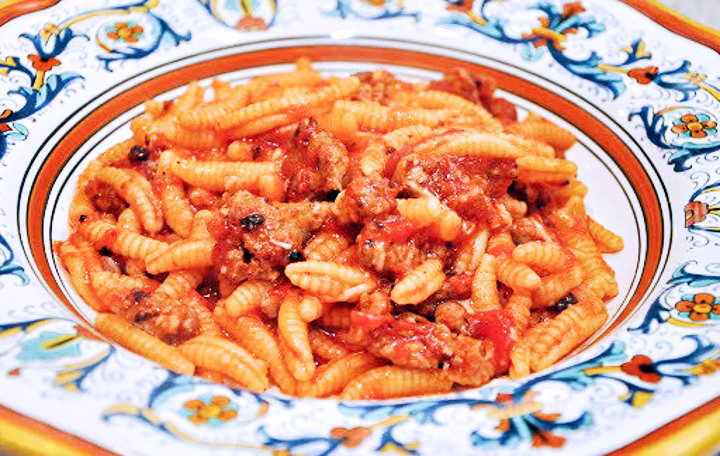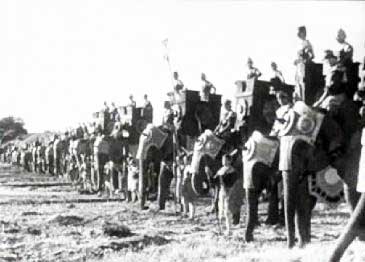Each region in Italy has its own pasta shapes and recipes. For the island of Sardinia, the shape is called malloreddus or gnocchetti sardi and the traditional dish using them is called Malloreddus alla Campidanese. It is named for Campidano, the fertile plain in the island’s southwest and uses the unique pasta in a sauce of tomatoes, sausage and saffron, which has been grown on the island for over 3,000 years.
The pasta is ubiquitous in Sardinia and often made using, of all things, a breadbasket. The size of the wicker is perfect for making the grooves in the pasta and the grooves are perfect for holding the sauce in Malloreddus alla Campidanese. Traditionally, malloreddus was made by taking a small piece of dough made from durum wheat rolled into a string-like shape. It was then flattened and curled so the two sides came together and then rolled down along the wicker of a basket to form the grooves. Our recipe below uses a more modern approach by making small sheets of the durum wheat and then cutting pieces to make the malloreddus.
Italy has always relied on Sardinia for its high-quality durum wheat. The island, particularly Campidano, is very fertile, with golden wheat fields as far as the eye can see. One of the reasons that the island has been occupied by foreign invaders throughout the centuries has been due to its wheat. When the Carthaginians took hold of Sardinia, they instituted a law intended to ensure that the wheat fields would remain pristine and receive as much sunlight as possible. How did they do this? Anyone who planted a tree adjacent to a wheat field faced the death penalty.
A few centuries later, it was the Romans who were the masters of Sardinia, exporting its wheat for use throughout the Empire. Sardinia became known as Rome’s granary. From the 3rd century BC, Campidano, whose population numbered less than 20 people per square mile, produced half of all the grain that was used to feed the Roman army. This continued for the better part of three centuries.
The name malloreddus comes from the Latin word mallolus, meaning ‘morsel.’ It is unclear when Malloreddus all Campidanese first appeared, but to many it would seem strange that the island’s most popular dish is a hearty pasta made with beef or lamb, rather than seafood. One reason proposed is that Sardinia’s population was for many centuries in constant fear of invasion. As such, the inhabitants retreated inland, turning its back on the sea and leaving the coasts largely unspoiled. This is one of the reasons behind why Sardinia’s beaches rank among the finest in the world. Instead of a coastal-centric society, farmers and shepherds cultivated wheat fields and herds of lambs and cows far inland, developing a cuisine that largely relied on meat. Hence, a meaty sauce and a unique pasta shape became the most traditional dish of Sardinia. One might describe Malloreddus alla Campidanese as being quintessentially Sardinian. Like the inland part of the island, it is a rugged dish whose beauty lies in its simplicity. Every ingredient tells a story of the island’s history, from its famous wheat to its saffron, tomatoes and delicious sausages, Malloreddus alla Campidanese is a dish that defines Sardinia.
Malloreddus
Ingredients
- 28 oz semolina
- 14 oz boiling water
- ½ tsp saffron
- 2 tsp salt
- 1 tbsp extra virgin olive oil
Preparation
Steep the saffron in boiling water for 10 minutes, then strain through a fine mesh sieve. In the bowl of a mixer fitted with a dough hook, combine all ingredients and knead for 10 minutes on medium speed. Remove the dough and place in plastic wrap and set aside until cool, about 1 hour.
On a floured surface, cut strips of dough about 1 inch-wide (keep the remaining dough covered in plastic wrap until ready to cut). Roll the dough to the thickness of 1/8 inch. Cut the sheet of dough into strips that are one inch wide and then into pieces measuring 1 inch by ½ inch.
On a gnocchi board or with the back of the tines of a fork, gently push each piece in a curling motion, flicking the piece of dough to make ridges on the gnocchi. If the dough is sticky, roll the pieces lightly in flour before making ridges. Alternatively, you can use the traditional Sardinian method of rolling the dough along a wicker bread basket to make the grooves. Toss malloreddus with semolina to keep the pieces from sticking together and store on sheet trays, lightly-lined with semolina, uncovered.
Malloreddus can be frozen flat on sheet trays and stored in an air-tight container for up to one month. Cook from frozen in seasoned boiling water.
Malloreddus alla Campidanese
Ingredients
- 2 cups strained, whole canned tomatoes
- 1 lb malloreddus
- 1 tbsp plus 1 tsp coarse salt, divided
- ½ cup extra-virgin olive oil
- 1 small red onion, finely chopped
- 1 small garlic clove, crushed
- 3/4 lb Italian sausage, casing removed and sausage roughly chopped
- 8 basil leaves, roughly chopped
- pinch dried red pepper flakes
- pinch saffron
- 1 cup finely grated Pecorino cheese, divided
Preparation
In a medium bowl, roughly crush the Italian tomatoes using your fingers. Bring a large pot of water to a boil over high heat. Add the pasta and 1 tablespoon of salt and cook until al dente. Drain the pasta, reserving ½ cup of pasta cooking water.
While the pasta water comes to a boil, start the sauce. In a large skillet set over a medium flame, add the olive oil, onion and garlic. Cook, stirring often, until the onion and garlic are tender and translucent, 4 to 6 minutes. Stir in the sausage, increase the flame to medium-high and cook, stirring often, until the liquid in the pan evaporates and the sausage browns – 8 to 10 minutes. Add the tomatoes, basil, red pepper flakes, saffron, remaining teaspoon of salt and the reserved pasta cooking water and bring to a simmer. Reduce the heat to medium-low and cook until the sauce is thick, about 35 minutes. Taste and season with more salt if needed.
Add the pasta to the sauce along with ½ cup of the Pecorino. Toss to combine and divide among four bowls. Sprinkle with the remaining Pecorino before serving.





